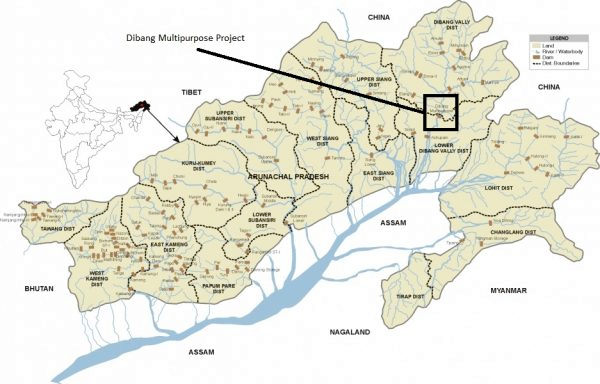Dibang Hydel Project | 28 Sep 2022
For Prelims: Dibang Hydel Project, Forest Advisory committee
For Mains: Growth and development over environment, NGT
Why in News?
Recently, the National Green Tribunal (NGT) has dismissed the case it took up suo motu on the grant of forest clearance for the 3000-MW Dibang hydel project without meeting the precondition of declaring a National Park.
- The Tribunal did so after it was informed by Arunachal Pradesh that the local people are not willing to part away their land for declaration of National Park.
What are the Key Points of Dibang Hydro Power Project?
- It is a flood control cum hydroelectric power project planned to be developed on the Dibang River, a tributary of Brahmaputra River, in Arunachal Pradesh.
- The Dam site is located about 1.5 km upstream of the confluence of Ashu Pani and Dibang rivers and about 43 km from Roing, District Headquarter.
- The project would moderate flooding in the areas downstream of the Dibang Dam during the entire monsoon period to the extent of 3000 cumecs.
- It will be developed with an estimated investment of USD 4 billion.
- The Dibang hydropower project is expected to generate up to 11,222 million units (MU) of electricity a year.
What is the National Green Tribunal (NGT)?
- It is a specialized body set up under the National Green Tribunal Act (2010) for effective and expeditious disposal of cases relating to environmental protection and conservation of forests and other natural resources.
- With the establishment of the NGT, India became the third country in the world to set up a specialised environmental tribunal, only after Australia and New Zealand, and the first developing country to do so.
- NGT is mandated to make disposal of applications or appeals finally within 6 months of filing of the same.
- The NGT has five places of sitting, New Delhi is the principal place of sitting and Bhopal, Pune, Kolkata and Chennai are the other four.
UPSC Civil Services Examination, Previous Year Questions (PYQs)
Prelims
Q. Which of the following is/are tributary/tributaries of Brahmaputra? (2016)
- Dibang
- Kameng
- Lohit
Select the correct answer using the code given below:
(a) 1 only
(b) 2 and 3 only
(c) 1 and 3 only
(d) 1, 2 and 3
Ans: (d)
Exp:
- Brahmaputra basin spreads over the countries of Tibet (China), Bhutan, India and Bangladesh. In India, it spreads over the states of Arunachal Pradesh, Assam, West Bengal, Meghalaya, Nagaland and Sikkim.
- The Brahmaputra River originates in the north from Kailash ranges of the Himalayas at an elevation of 5,150 m just south of the lake Konggyu Tsho and flows for about a total length of 2,900 km. It enters India at Namcha Barwa (Arunachal Pradesh) and flows for 916 km.
- The principal tributaries of the river joining from the right are Kameng, Subansiri, Manas, Sankosh and Teesta whereas Lohit, Dibang, Burhidihing, Desang, Dikhow, Dhansiri join it from the left. Hence, 1, 2 and 3 are correct.
- Therefore, option (d) is the correct answer.
Mains
Q1. What do you understand by Run-of-river hydroelectricity project? How is it different from any other hydroelectricity project? (2013)
Q2. Suppose the Government of India is thinking of constructing a dam in a mountain valley bound by forests and inhabited by ethnic communities. What rational policy should it resort to in dealing with unforeseen contingencies? (2018)

